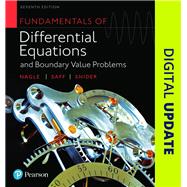An introduction to the basic theory and applications of differential equations
Fundamentals of Differential Equations and Boundary Value Problems presents the basic theory of differential equations and offers a variety of modern applications in science and engineering. This flexible text allows instructors to adapt to various course emphases (theory, methodology, applications, and numerical methods) and to use commercially available computer software. For the first time, MyLab™ Math is available for this text, providing online homework with immediate feedback, the complete eText, and more.
Note that a shorter version of this text, entitled Fundamentals of Differential Equations, 9th Edition, contains enough material for a one-semester course. This shorter text consists of chapters 1-10 of the main text.
Also available with MyLab Math
MyLab™ Math is an online homework, tutorial, and assessment program designed to work with this text to engage students and improve results. Within its structured environment, students practice what they learn, test their understanding, and pursue a personalized study plan that helps them absorb course material and understand difficult concepts.
Note: You are purchasing a standalone product; MyLab does not come packaged with this content. Students, if interested in purchasing this title with MyLab, ask your instructor for the correct package ISBN and Course ID. Instructors, contact your Pearson representative for more information.
If you would like to purchase both the physical text and MyLab, search for:
0134665694 / 9780134665696 Fundamentals of Differential Equations and Boundary Value Problems Plus MyLab Math with Pearson eText -- Access Card
Package consists of:
- 0321431308 / 9780321431301 MyLab Math -- Glue-in Access Card
- 0321654064 / 9780321654069 MyLab Math Inside Star Sticker
- 0321977106 / 9780321977106 Fundamentals of Differential Equations and Boundary Value Problems









